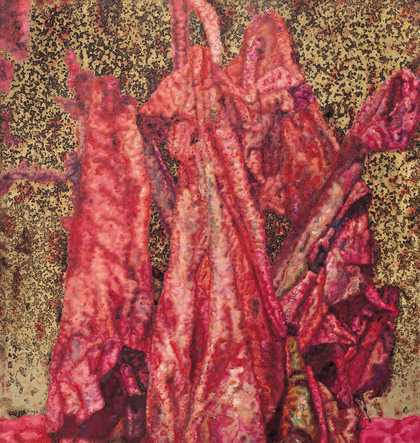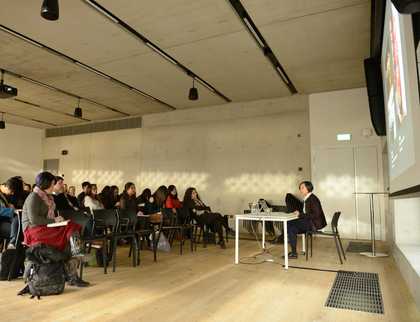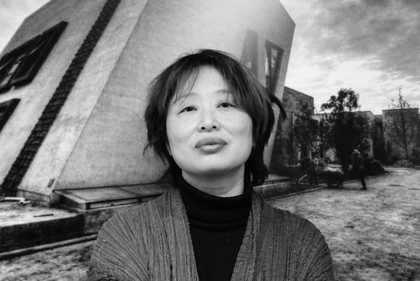Monica Merlin: Let’s start by talking about the time you first began making art.
Cai Jin: I was at university in the 1980s. Back then, we came into contact with impressionism quite a lot. I went to university in Anhui, which is very far from Beijing, so we did not always know about the latest things. But at my university, we still looked at art books; particularly books with impressionist works. At that time, I liked the works of Van Gogh and other impressionists. After I graduated from university in 1989, I went to Beijing and came into contact with many artists and teachers. Then I studied at the China Central Academy of Fine Arts, where I learnt a great deal.
Monica Merlin: Did you know about the 1989 China Avant-Garde exhibition, the big exhibition of Chinese contemporary art that took place in Beijing in 1989?
Cai Jin: I knew a little at the time, but I did not know very much about experimental art. That was something very remote for me, because we did not take part in it. But I knew about shows like China Avant-Garde.
Monica Merlin: Did you go to it?
Cai Jin: I did not see it because I was in Anhui at the time. I had not been to Beijing yet, so it was only later that I learnt about this important exhibition. I arrived in Beijing in 1989 and I saw a lot of shows in 1990 and 1991.
Monica Merlin: In the 1990s, you were one of the most famous and important women artists in China, and you started taking part in many exhibitions.
Cai Jin: It happened very quickly and I did not expect it. For example, when I was in Beijing, I studied for two years at the China Central Academy of Fine Arts. Afterwards, I was lucky enough to take part in the exhibition called Chinese New Art, Post-89, curated by Li Xianting and Chang Tsong-zung in Hong Kong. That was the first contemporary art exhibition I took part in. It was a very important show and I had the opportunity to exhibit my work. From then on, people knew about my paintings and I gradually began to participate in more shows, women artists’ shows in particular. At first I took part in exhibitions curated by Liao Wen. Later on, I started to participate in bigger shows. There were lots of them in the 1990s, especially after 1992.
Monica Merlin: Was that when you started to use second-hand objects in your art?
Cai Jin: I started to use second-hand objects in 1995. These were items from our daily lives: mattresses, sofas and bike seats, for example. I chose those three things in 1995. I thought it was visually very effective when you painted on them. It felt very different from painting on canvas, so I thought it was a very interesting discovery. When I went to America in 1997 to take part in some shows and activities, I added some more new materials. I went to second-hand shops to find old stuff – things that gave me a certain feeling: women’s shoes, bathtubs and cushion covers all started to appear in my art. I felt it was very effective. Then I went on to work with silk duvet covers. I have always thought that these materials suit my art.
Monica Merlin: Let’s start by talking about the time you first began making art.
Cai Jin: I was at university in the 1980s. Back then, we came into contact with impressionism quite a lot. I went to university in Anhui, which is very far from Beijing, so we did not always know about the latest things. But at my university, we still looked at art books; particularly books with impressionist works. At that time, I liked the works of Van Gogh and other impressionists. After I graduated from university in 1989, I went to Beijing and came into contact with many artists and teachers. Then I studied at the China Central Academy of Fine Arts, where I learnt a great deal.
Monica Merlin: Did you know about the 1989 China Avant-Garde exhibition, the big exhibition of Chinese contemporary art that took place in Beijing in 1989?
Cai Jin: I knew a little at the time, but I did not know very much about experimental art. That was something very remote for me, because we did not take part in it. But I knew about shows like China Avant-Garde.
Monica Merlin: Did you go to it?
Cai Jin: I did not see it because I was in Anhui at the time. I had not been to Beijing yet, so it was only later that I learnt about this important exhibition. I arrived in Beijing in 1989 and I saw a lot of shows in 1990 and 1991.
Monica Merlin: In the 1990s, you were one of the most famous and important women artists in China, and you started taking part in many exhibitions.
Cai Jin: It happened very quickly and I did not expect it. For example, when I was in Beijing, I studied for two years at the China Central Academy of Fine Arts. Afterwards, I was lucky enough to take part in the exhibition called Chinese New Art, Post-89, curated by Li Xianting and Chang Tsong-zung in Hong Kong. That was the first contemporary art exhibition I took part in. It was a very important show and I had the opportunity to exhibit my work. From then on, people knew about my paintings and I gradually began to participate in more shows, women artists’ shows in particular. At first I took part in exhibitions curated by Liao Wen. Later on, I started to participate in bigger shows. There were lots of them in the 1990s, especially after 1992.
Monica Merlin: Was that when you started to use second-hand objects in your art?
Cai Jin: I started to use second-hand objects in 1995. These were items from our daily lives: mattresses, sofas and bike seats, for example. I chose those three things in 1995. I thought it was visually very effective when you painted on them. It felt very different from painting on canvas, so I thought it was a very interesting discovery. When I went to America in 1997 to take part in some shows and activities, I added some more new materials. I went to second-hand shops to find old stuff – things that gave me a certain feeling: women’s shoes, bathtubs and cushion covers all started to appear in my art. I felt it was very effective. Then I went on to work with silk duvet covers. I have always thought that these materials suit my art.

Cai Jin
Banana Plant series 1994
22 x 190 cm
Courtesy of the artist
Monica Merlin: How does the art you created then – for example, the Banana Plant (Meiren jiao) series – relate to the art you do today?
Cai Jin: I think it is all a continuation. For example, people have heard the title Banana Plant for over 20 years, because it has been the subject of my art for a long time. The most recent works are called Landscape (Fengjing), and perhaps they are not as rich in imagery as Banana Plant. However, although Landscape does not have the same shapes as Banana Plant, there is actually a close relationship between the two series. In Landscape, the image is no longer there and lots of things are scattered. The paintings are now more relaxed and a bit freer.
Monica Merlin: Can you explain the significance of Landscape to you?
Cai Jin: Landscape is not an actual landscape that I can see in reality. It is perhaps a pattern in my mind or a shape that I can feel. Maybe it is something that comes when I am very relaxed, something that unfolds upon the painting. It is something abstract, different from the landscapes in reality. In this series, there is space to reveal more than what we see.
Monica Merlin: Can you tell me about your relationship with colour? Looking at your art, you can immediately see that colour is very important.
Cai Jin: In my art, I think that colour and brush strokes are important. The feeling of the painting emerges through these two elements. I actually do not give much thought to the feelings attached to colour – it is not something that I emphasise. Perhaps it is merely a habit of mine: I just do what I like. It does not really have any substance or any particular meaning, but it may be related to the state I am in when I am painting. It just happened to be the colour I picked. For me, any colour can come up in my paintings, but they have to wait for their turn. For example, I may pick one colour this year, and change it to another colour at a different time. Any colour could emerge.
Monica Merlin: What do you think is the relationship between your works and femininity?
Cai Jin: I myself have not spent that much time thinking about whether they have a relationship or not, but at the same time, I think that as a woman these works have a relationship to me. That is the only way I can explain it. I do not think there is a need for me to bring particular attention to what I am doing – or to call what I am making ‘women’s art’ – because I am female myself.
Monica Merlin: Some critics say that your art is feminist. What do you think when you read these articles?
Cai Jin: I think that this is normal and that their analysis makes sense. When people see your art, they will have their own understanding of it. I am grateful if people have their own experience when they see my artworks. I am very happy to hear people’s discussions, opinions and experiences of my art. This helps me a lot. While I do not pay attention to much else when I am painting, learning about other people’s reactions allow me realise that perhaps there are emotions in my work that people can feel. If that is the case, I welcome it.
Monica Merlin: Are you currently planning new works or a new series? Or do you think that your works will be different in the future?
Cai Jin: With the way I paint, I never have a plan. I do not think about what I want people to see or what I should paint. I have never done that. I think it comes naturally. I just paint what I want.
Monica Merlin: It is an instinct.
Cai Jin: Yes, it is an instinct. It is very simple: I am still painting what I was painting before. It seems like there is not much change, but in fact I believe that each time, each painting has something different. The most important thing is that each change expresses something from within. It should not be about showing people what I’ve done each year – it is not like this year I painted bathtubs, so next year I will paint something different for a change. I would not change that way.
When I started painting bathtubs, I did not plan to choose bathtubs. I came up with the idea because I saw some bathtubs on that day and I suddenly wanted to paint them. Obviously I had seen bathtubs before, but I did not think about painting them – it is only when I saw them on a day I wanted to paint that I thought about painting them. This all comes naturally. So I do not know what I will do next. I just believe in what I am doing at the moment.
Monica Merlin: When you teach at the Tianjin Fine Arts Institute, how do you encourage your students? If they want to continue practicing art, what advice do you give them?
Cai Jin: My students are very confused because of what they study and because they are young. They can not necessarily achieve what they want during those few years at the institute. It took me many years to be able to achieve what I wanted. At the institute, I mostly encourage them, and try to make them believe that many exciting things await them in the future. At this particular moment, they may feel like, ‘oh that artist has done this but I cannot paint like that’. So I want to tell them that in the future they can do all of those things. Most of the time, I advise them to find themselves in their homework or their own work. Of course, they can study the work of good artists too. Students don’t need to worry if their paintings are similar to the great artists; this is part of studying. At this point, I advise them to increase their understanding and then to gradually find their own style.
After they leave the institute, they need to persevere in their lives as artists. They cannot become successful artists overnight, so they need to persevere in their art. This is very important. You cannot say that just because you cannot paint the way you want in the couple of years you are at university, you will never be able to do it. You need to persevere. It needs time. Lots of my students have done it – they are still artists a few years after leaving the institute and they are doing very well.
Monica Merlin: What do you think about the state of women artists in Chinese contemporary art?
Cai Jin: I think that there are lots of events and exhibitions for women artists all over the country, not just in Beijing. You could say that there is one each month. So I think the situation for women artists is good. They can paint, and different people will come to them with invitations. Good curators will approach those artists. So I think overall women are doing well in the art scene. However, it seems like there are still not enough good exhibitions showing women artists’ works; they exist, but there are not enough.
Monica Merlin interviewed Cai Jin in her studio in Beijing on 19 November 2013.



